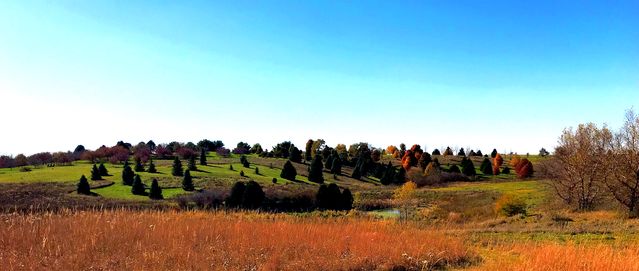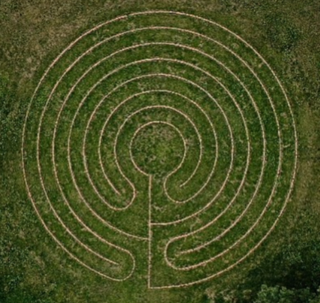Meditation
You Never Get Lost In This Ancient Exercise
One Way In, One Way Out: The Meditative Journey of Walking a Labyrinth
Posted December 6, 2019

It’s a sunny November day and I have found my meditative spot in the Iowa countryside—a labyrinth tucked into a grove of conifers at the Brenton Arboretum in Dallas Center, a short drive from the capital of Des Moines. I walk contemplatively, purposefully going back and forth, back and forth, until I reach the center. I am wearing my Fitbit, and the short 900-step walk takes me ten minutes.
I am in no hurry—that’s the point of a labyrinth. It’s a blessed change from everyday life when I feel the need to rush from one thing to another. In fact, in an ironic twist, I got a speeding ticket driving to the arboretum. Maybe I’ll be able to slow down when I go back.
The labyrinth is on a hillside, but I’m protected from the wind by a barrier of Eastern White Pines. I’m almost in the middle of the 148-acre arboretum and the silence is comforting. A tractor whirrs in the distance; I focus on that soft, faraway noise, then tune it out and listen only to my breathing, my eyes downward, watching the grass path as it increasingly turns inward.

Most labyrinths consist of a winding path looped symmetrically within a large circle, with an open center. If you look at the diagram of a labyrinth, you essentially see a metaphor for meditation: focus on the path, stay the course, be in the moment. Your reward: finding your center. Some early labyrinths were handheld or painted on walls, intended to be touched rather than walked. Today, the internet brims with “finger” labyrinths in wood, pewter, ceramic, even plastic. They work like non-sectarian prayer beads or a rosary—your finger slowly traces the path so you can take a meditation break just about anywhere. You can even download your own from Contemplative Mind.
But walking a labyrinth in nature boosts your rewards exponentially, adding the soothing benefits of being around greenery: an overall improvement in mental well-being through a reduction in depression, stress, and mental fatigue. Time in green spaces can even help you quit smoking and improve your diet.
The labyrinth I am walking is made of mowed pasture grass, with bricks lining the path. It was built in 2016, one of roughly 10,000 permanent labyrinths worldwide—in parks, public gardens, prisons, parks, airports, retreat centers, and community centers. The American Psychological Association in Washington DC has a 42-foot rooftop labyrinth. More than 100 medical facilities in the United States, including hospitals and hospices, have walking labyrinths. I’ve walked labyrinths all around the world, but perhaps the most spectacular were in Alaska and Hawaii, both with views of the Pacific Ocean.
But it is hard to beat the tranquility of an Iowa prairie.
You Never Get Lost
“Our labyrinth encourages people to make connections with their environment on multiple levels,” says Melissa Burdick, executive director of the Brenton Arboretum. “You're in the open air. You’re walking, so your body is engaging with the environment. You have a mental connection because you know your goal is to meditate. Emotionally, you start becoming aware of changes in your body. It’s soothing.”
Labyrinths have their roots in ancient civilizations and show up in Roman mosaics, Spanish walls, Egyptian tombs and medieval churches, most enduringly at Chartres Cathedral. There is only one way in and out of a labyrinth; you don't have to think about the path and are therefore open to losing yourself in the calming, repetitive motion of getting to the center. A labyrinth has open sight lines, so you can soak in your setting.
“You never get lost in a labyrinth,” Burdick says.
How Is A Maze Different?
We often confuse labyrinths with mazes, because both consist of paths and are often created in nature of organic materials. But a maze has multiple ins and outs, with hidden pathways surrounded by a hedge or wall. A maze challenges you to find your way out. There are multiple solutions, and the walk often leads to a dead end. It’s a puzzle for you to solve. Mazes also have ancient roots—the term “maze” comes from the Middle English word for “delirium” or “delusion.” It’s an agricultural term for breaking away from the straight furrow of a plowed field.
A maze is a challenge, a labyrinth is a comfort.
A Guide to Walking a Labyrinth
Your goal with a labyrinth is always to get to the center, and the path takes you there. You can go as slowly as you want, but the back-and-forth weaving makes it difficult to hurry through. You can be deliberate about your goals, consciously centering yourself before you start, jettisoning your worries and preoccupations. Or you can just go along with the path and let yourself be.
The main points of a labyrinth—the entry, the path, the center, and the ending—encourage different levels of mindfulness:
•Before you step on to the path, take a few slow breaths in and out, in and out, in and out. Consider your goal for this walk. You might be looking for clarity, wanting to reduce stress, trying to deal with grief, or looking for a moment with yourself. Or it could just be a nice day and you simply want to spend some of it outside. Don't overcomplicate. Just be. Look at your surroundings, breathe in and out again, and begin.
•Give the path your attention and, in return, it will guide you. No need to think about where or how or what. Just go. Some people walk with a mantra (“I am here, I am good, this is good;” “I am strong, I am enough”) some say a prayer of hope or gratitude, some ask for clarity, and some just keep moving and let their minds stay open.
•Once you reach the center, take time to be thankful. Breathe in, breathe out. Assess and appreciate your setting. Take as long as you want there and, when you’re ready, step back onto the path.
•At the end, stop for a moment and give thanks. Some labyrinths have bells to ring to signal your completion and to gently awaken you back.
Each time you walk, you’ll do it a bit differently, with different rhythms depending on where your life is at that time. “Everybody has different ways of approaching a labyrinth,” Burdick says. “Everybody has their own journey. It’s personal.”
Today, I walk the labyrinth twice. The first time, I shake my brain clean, get accustomed to the wind, and feel the sun. The second walk is for solemn meditation. I walk alone and therefore am not distracted by what somebody else is doing, how they’re doing it, or what they think of me.
I am here for stress release, so I focus on my breathing and let my mind go where it will. The pasture grass is a bit rough, but I like that. It feels natural, and it literally keeps me grounded. I pay attention to my feet, my walk, the earth.

I turn slowly in the middle and breathe in, then out. In, out several times. I raise my eyes and reorient myself with my environment. I can see the bewitching metal statue of St. Francis and the Birds, by artist Frederick Franck, silhouetted against the azure sky. I stare at the birds who, although unmoving, feel like they are aflight. I look across the arboretum, at the maples still holding their leaves, the bare oaks in the distance, and the dark emerald pines. The air is crisp, with the whiff of Iowa: grass, manure, dirt. I gaze out across the hills, at the ancient Earth, and exhale long and slowly. The tractor whirrs.
I step back onto the path and walk slowly, deliberately, until I get to the end and its gentle exit, back to the land. I stop, breathe in, then out, and reluctantly step out, exhale, then walk to my car. I drive home slowly. Or, at least, slower.
YOU MIGHT ALSO LIKE: The Garden As Prayer: Gardening is a way of talking to God and leaving a transcript behind.
READ MORE ABOUT THE BENEFITS OF WALKING IN NATURE:
Yes, You Can Bathe in the Forest: A few hours in a natural environment and your blood pressure and stress drop.
The Solace of Nature: You can reduce unhealthy cravings just by looking at green spaces.




